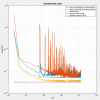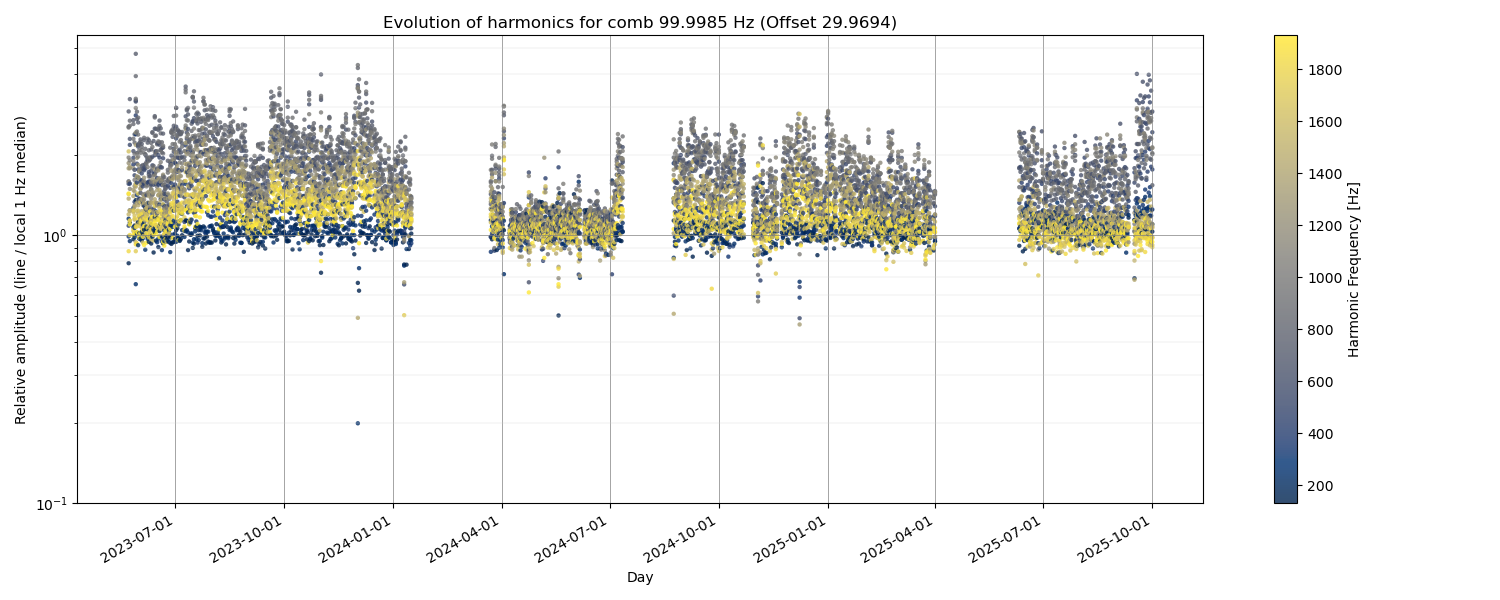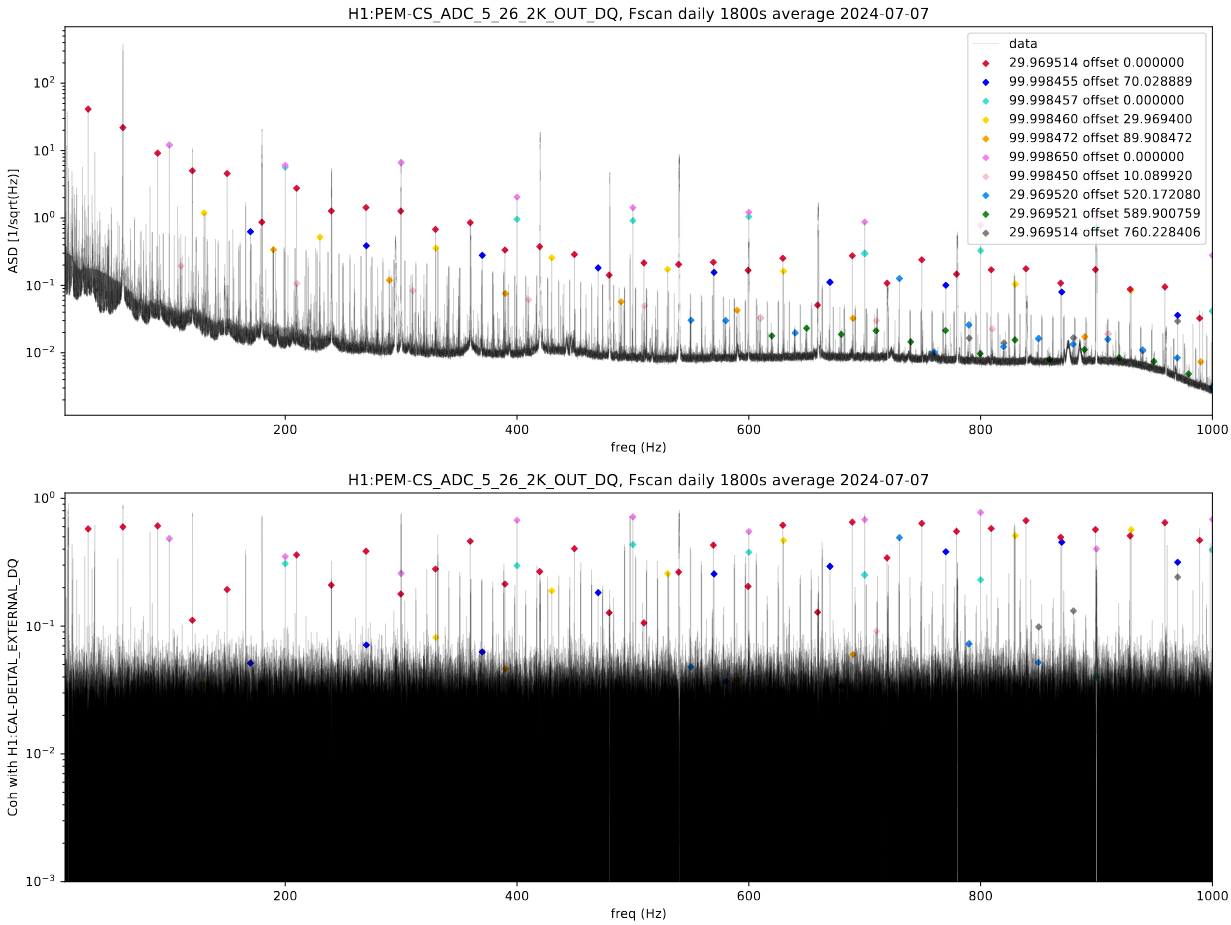TITLE: 10/20 Day Shift: 1430-2330 UTC (0730-1630 PST), all times posted in UTC
STATE of H1: Observing at 151Mpc
INCOMING OPERATOR: Ryan S
SHIFT SUMMARY:
IFO is in NLN and OBSERVING
The day started and we were locked until planned commissioning from 8:30AM PT to 11:30 AM PT. Commissioning was somewhat light.
15:34 UTC - No SQZ Time Start, Start of COMMISSIONING
16: 04 UTC - No SQZ Time End (30 mins)
16:09 UTC - Matt ran ISS Injections (unfinished)
16:35 UTC - Lockloss (alog 87578)
16:51 UTC - Initial Alignment after bad flashes
During Reacquisition: TJ updated INP1_P and CSOFT_ P Gains from -1 to -2 and 25 to 30 respectively, which should avoid ringup locklosses. (alog 87582)
During Reacquisition: TJ switched the LASER_PWR node input to use the IM4 TRANS signal (post PSL). (alog 87581) - this will result in kappa C being off by 2-3% until we update gains, which is planned for tomorrow.
18:09 UTC - NLN Reacquired
18:10 UTC - Oli Estimator commissioning
18:31 UTC - Back to OBSERVING, End of COMMISSIONING
Start of SQZ Issues (total time out of OBSERVING 1hr 15 mins)
18:59 UTC - Dropped out of OBSERVING to optimize SQZ (range was 145 and not usual 151). This caused a lot of issues due to FC unlocking due to opo temp guardian seemingly causing FC to drop out, requiring me to trend and reset FC1, FC2 and ZM3 P and Y. (alog 87587)
19:39 UTC - Back to OBSERVING to see if changes were fixed - they weren’t - range was now ~143.
19:42 UTC - Back to COMMISSIONING. Assuming that the FC locking issues were fixed, now I could optimize angle and opo (in that order).
19:47 UTC - Back to OBSERVING. I had run the SQZ_ANG_ADJUST and it worked but didn’t improve range. If anything, the range dipped to 139 now… Maybe this was a thermalizing thing and I was getting ahead of myself. So I waited the remaining 30 mins until we thermalized fully.
20:17 UTC - Back to COMMISSIONING. Then, I ran the SCAN_OPO_TEMP guardian but once again, it unlocked the FC and the values got reset and had to be adjusted by hand. This is where I realized that the OPO_TEMP unlocking the FC might be unrelated and that I may have to adjust the OPO_TEMP manually. (went back to observing accidentally for a minute or two)
Back to OBSERVING for rest of Shift
21:08 UTC - Back to OBSERVING for final time. After relocking SQZ by trending back values for FC2, FC1 and ZM3, was able to bring them back to normal. Range is now around 144, which means technically nothing worked. However, I think any further attempts to play with the opo temp may risk FC lockloss and more time out of OBSERVING. As such, we should just optimize what we can tomorrow/pick an opportunistic time for leaving OBSERVING.
LOG:
| Start Time | System | Name | Location | Lazer_Haz | Task | Time End |
|---|---|---|---|---|---|---|
| 14:45 | FAC | Randy | X-arm Beam Tube | N | Caulking holes | 21:58 |
| 14:45 | FAC | Nellie | Optics Lab | N | Technical Cleaning | 14:54 |
| 15:49 | FAC | Nellie | MY | N | Technical Cleaning | 16:25 |
| 16:24 | FAC | Nellie | MX | N | Technical Cleaning | 17:07 |
| 16:29 | FAC | Tyler | BT Enclosure Overpass | N | Tape off splaying area | 16:43 |
| 16:33 | EE | Fil | MY | N | Part pickup | 17:08 |
| 20:16 | ISS | Rahul, Keita | Optics Lab | Local | ISS Array | 22:31 |
| 21:14 | VAC | Janos, Journalist | Overpass | N | Tour | 22:14 |
| 22:58 | Tour | Matt +1 | Vac Prep Lab | N | Show and tell | 00:58 |
| 23:05 | ISS | Rahul, Keita | Optics Lab | N | ISS Array | 00:05 |

















 We list here the channels that do show most of these Combs. These same channels do show changes in coherence between July 1st and July 7th 2024, but do not show changes in the amplitude of the combs.
- H1_IMC-F_OUT_DQ
- H1_LSC-MCL_IN1_DQ
- H1_LSC-MICH_IN1_DQ
- H1_LSC-SRCL_IN1_DQ
- H1_PEM-CS_MAG_EBAY_LSCRACK_X_DQ
- H1_PEM-CS_MAG_EBAY_LSCRACK_Y_DQ
- H1_PEM-CS_MAG_EBAY_LSCRACK_Z_DQ
- H1_PEM-CS_MAG_LVEA_INPUTOPTICS_X_DQ
- H1_PEM-CS_MAG_LVEA_INPUTOPTICS_Y_DQ
- H1_PEM-CS_MAG_LVEA_INPUTOPTICS_Z_DQ
In most channels, the comb amplitude tends to get quite low after ~1500 Hz. The following sets of channels show differences between X, Y and Z:
- H1_PEM-CS_MAG_EBAY_SUSRACK_X_DQ (Higher amplitudes and towards higher frequencies)
- H1_PEM-CS_MAG_EBAY_SUSRACK_Y_DQ (Lower comb amplitudes)
- H1_PEM-CS_MAG_EBAY_SUSRACK_Y_DQ (Lower comb amplitudes)
Regarding CS_MAG_LVEA_OUTPUTOPTICS, these combs can be seen best in X, weaker in Y and almost non-existent in Z. (In CS_MAG_LVEA_INPUTOPTICS they look roughly the same height)
- H1_PEM-CS_MAG_LVEA_OUTPUTOPTICS_X_DQ (Strongest)
- H1_PEM-CS_MAG_LVEA_OUTPUTOPTICS_Y_DQ (Weaker lines)
- H1_PEM-CS_MAG_LVEA_OUTPUTOPTICS_Z_DQ (Almost no lines)
Same behavior at:
- H1_PEM-CS_MAG_LVEA_VERTEX_X_DQ (Strongest lines)
- H1_PEM-CS_MAG_LVEA_VERTEX_Y_DQ (Weaker lines)
- H1_PEM-CS_MAG_LVEA_VERTEX_Z_DQ (Almost no lines)
We can see that these combs mostly appear in the corner station. The combs do not appear in neither EX nor EY channels. However, comb 99.99865 Hz offset 0.000 appears in many EX, EY channels and does become more coherent after July 7th. However, it is very close to 100 Hz so it may be influenced by other round-number combs (?)
We list here the channels that do show most of these Combs. These same channels do show changes in coherence between July 1st and July 7th 2024, but do not show changes in the amplitude of the combs.
- H1_IMC-F_OUT_DQ
- H1_LSC-MCL_IN1_DQ
- H1_LSC-MICH_IN1_DQ
- H1_LSC-SRCL_IN1_DQ
- H1_PEM-CS_MAG_EBAY_LSCRACK_X_DQ
- H1_PEM-CS_MAG_EBAY_LSCRACK_Y_DQ
- H1_PEM-CS_MAG_EBAY_LSCRACK_Z_DQ
- H1_PEM-CS_MAG_LVEA_INPUTOPTICS_X_DQ
- H1_PEM-CS_MAG_LVEA_INPUTOPTICS_Y_DQ
- H1_PEM-CS_MAG_LVEA_INPUTOPTICS_Z_DQ
In most channels, the comb amplitude tends to get quite low after ~1500 Hz. The following sets of channels show differences between X, Y and Z:
- H1_PEM-CS_MAG_EBAY_SUSRACK_X_DQ (Higher amplitudes and towards higher frequencies)
- H1_PEM-CS_MAG_EBAY_SUSRACK_Y_DQ (Lower comb amplitudes)
- H1_PEM-CS_MAG_EBAY_SUSRACK_Y_DQ (Lower comb amplitudes)
Regarding CS_MAG_LVEA_OUTPUTOPTICS, these combs can be seen best in X, weaker in Y and almost non-existent in Z. (In CS_MAG_LVEA_INPUTOPTICS they look roughly the same height)
- H1_PEM-CS_MAG_LVEA_OUTPUTOPTICS_X_DQ (Strongest)
- H1_PEM-CS_MAG_LVEA_OUTPUTOPTICS_Y_DQ (Weaker lines)
- H1_PEM-CS_MAG_LVEA_OUTPUTOPTICS_Z_DQ (Almost no lines)
Same behavior at:
- H1_PEM-CS_MAG_LVEA_VERTEX_X_DQ (Strongest lines)
- H1_PEM-CS_MAG_LVEA_VERTEX_Y_DQ (Weaker lines)
- H1_PEM-CS_MAG_LVEA_VERTEX_Z_DQ (Almost no lines)
We can see that these combs mostly appear in the corner station. The combs do not appear in neither EX nor EY channels. However, comb 99.99865 Hz offset 0.000 appears in many EX, EY channels and does become more coherent after July 7th. However, it is very close to 100 Hz so it may be influenced by other round-number combs (?)


















